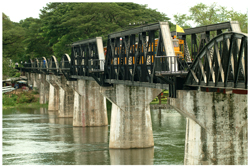"แคว้นโบราณ ด่านเจดีย์ มณีเมืองกาญจน์
สะพานข้ามแม่น้ำแคว แหล่งแร่น้ำตก" |

According to most historians, the ancient town of Kanchanaburi was located near Ban Lat Ya, a small village situated approximately 16 kilometers north of the present town. The site was repeatedly recorded in Thai history as an invasion route which the Burmese used to enter Thai Kingdoms.
 Kachanaburi, which has mostly mountainous terrain, covers an area of approximately 19,473 square kilometers and is the third largest province in Thailand after Chiang Mai and Nakhon Ratchasima. Situated approximately 129 kilometres west of Bangkok, Kanchanaburi shares a border with Myanmar to the west, Tak and Uthai Thani Provinces to the north, Suphan Buri and Nakhon Pathom Provinces to the east, and Ratchaburi Province to the south.
Kachanaburi, which has mostly mountainous terrain, covers an area of approximately 19,473 square kilometers and is the third largest province in Thailand after Chiang Mai and Nakhon Ratchasima. Situated approximately 129 kilometres west of Bangkok, Kanchanaburi shares a border with Myanmar to the west, Tak and Uthai Thani Provinces to the north, Suphan Buri and Nakhon Pathom Provinces to the east, and Ratchaburi Province to the south.

In north and west Kanchanaburi, the terrain is comprised mainly of mountains and high plains, with the Thanon Thongchai Range acting as a natural border between Thailand and Myanmar. The range is the source of Kanchanaburi’s two most important rivers Maenam Khwae Noi and Maenam Khwae Yai, which form the famous Maenam Mae Klong. As a result, several of Thailand’s largest Namtok (waterfalls) and most extensive wildlife sanctuaries are found in this area.
 The magnificent landscape and charming beauty of Kanchanaburi have resulted in major tourist attractions including several well-known waterfalls, caves which were once inhabited by Neolithic man, pristine national parks, tranquil rivers, virgin forests, and reservoir. Together, they offer an intriguing experience for first-time or repeat visitors. Whether its fishing, rafting, canoeing, mountain biking, bird-watching, star-gazing, golfing, elephant and jungle trekking, or even living in bamboo rafts, Kanchanaburi takes pride in offering them all.
The magnificent landscape and charming beauty of Kanchanaburi have resulted in major tourist attractions including several well-known waterfalls, caves which were once inhabited by Neolithic man, pristine national parks, tranquil rivers, virgin forests, and reservoir. Together, they offer an intriguing experience for first-time or repeat visitors. Whether its fishing, rafting, canoeing, mountain biking, bird-watching, star-gazing, golfing, elephant and jungle trekking, or even living in bamboo rafts, Kanchanaburi takes pride in offering them all.
 The city of Kanchanaburi is located at the point where two tributaries, the Khwae Noi and Khwae Yai meet and form the Maenam Mae Klong. This is the location of the notorious Death Railway and the Bridge on the River Khwae one of the worlds famous World War II sites which have been immortalized in print and film.
The city of Kanchanaburi is located at the point where two tributaries, the Khwae Noi and Khwae Yai meet and form the Maenam Mae Klong. This is the location of the notorious Death Railway and the Bridge on the River Khwae one of the worlds famous World War II sites which have been immortalized in print and film.
In economic terms, Kanchanaburi has been doing well on a national scale, with over 10 per cent growth annually. Important industries include sugar, agricultural products and jewelry. Tourism is also a main source of income for the locals as the provinces high tourism potential has made Kanchanaburi number one among the west provinces in having the highest number of visitors each year.
Residents of Kanchanaburi are engaged in agricultural activities. Most of the locals are of Thai ancestry with notable Mon and Karen minorities. Rural dwellers enjoy living simply and respecting nature. Moreover folk music and dances dating back at least 500 years are still performed today.